Floor boards Sche designed to power two, three or four apartments, as well as to install devices for telephone, television and radio broadcasting networks, they are used in lighting and power plants of residential, public, administrative, industrial buildings and structures, as well as other similar buildings. Floor boards Sche designed to receive and distribute electrical energy in three-phase four-wire and five-wire networks with a voltage of 380/220V and a frequency of 50Hz with a grounded neutral, infrequent switching on and off of group circuit lines, as well as for their protection in case of overloads and short circuits.
The design of the board of the storey switchgear
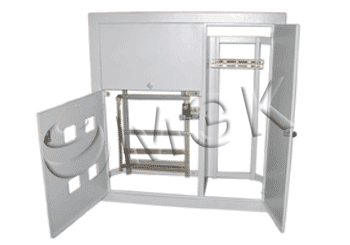 Sche is a welded metal structure, divided by a partition into three compartments: a metering compartment, a distribution compartment and a low-current one. In the accounting department, single-phase or three-phase meters are installed. In distribution panel Sche provides for the installation of automatic switches and devices protective shutdown(RCD). Compartment access Sche provided from the facade through the doors. The metering compartment door has windows for taking meter readings, covered with a transparent material.
Sche is a welded metal structure, divided by a partition into three compartments: a metering compartment, a distribution compartment and a low-current one. In the accounting department, single-phase or three-phase meters are installed. In distribution panel Sche provides for the installation of automatic switches and devices protective shutdown(RCD). Compartment access Sche provided from the facade through the doors. The metering compartment door has windows for taking meter readings, covered with a transparent material.
Types of produced SC
Overall dimensions of floor switchboards
| Overall dimensions, mm |
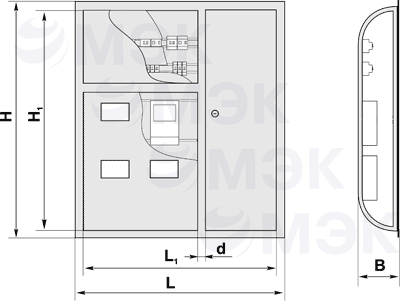 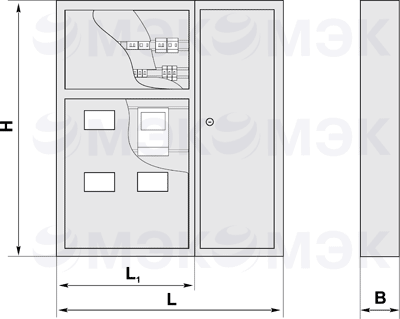 |
||||||
| H | H1 | L | L1 | B | d* | ||
| 980 | 900 | 960 | 880 | 155 | 130 | ||
| 1220 | 1140 | 1000 | 920 | 155 | 130 | ||
| 1200 | 750 | 550 | 155 | ||||
| 1200 | 750 | 550 | 155 | ||||
Schematic diagram of the switchgear
ShchE -1-1-4 UHL4: circuit diagram primary connections| Elements on the diagram |
Device symbol structure
SHRE -X-Y-Z UHL4| SHRE | Floor distribution board |
| X | Execution of the shield for installation: 1 - recessed; 2 - hinged; |
| Y | Power supply type: 1 - single-phase; 2 - three-phase; |
| Z | Execution of the shield according to the number of recorded apartments: 2 - for two apartments; 3 - for three apartments; 4 - for four apartments; |
| UHL4 | Type of climatic version according to GOST 15150-69 and GOST 15543.1-89 |
An example of recording a device when ordering it: “ShchRE-1-1-4 UHL4 switchboard”: Floor-mounted distribution switchboard for installation, single-phase for four apartments.
Completeness of delivery of floor boards
Internal electrical devices begin with SchE.
Reception, distribution and metering of electricity on a single floor is carried out by special electrical equipment, which is called by professionals Sche, or if plain language- storey shield. This device is a standard electrical equipment, which can be conditionally divided into two components: a steel case and internal hardware content. Inside Sche is divided into three compartments, which are filled with specialized devices:
- Residual current block, which is triggered by power surges in the network or in the event of a short circuit.
- A metering unit in which electricity meters are located.
- A block of low-voltage equipment that contains television and telephone hubs.
Servicing the SE and measures to combat vandals.
It is clear that the body Sche designed not to decorate the interior, but to counteract intruders. To do this, it is closed with a lock, the keys to which have the attendants. AT apartment buildings floor shields are located near the apartments, there are always windows in the shield door for visual control of meter readings. Service maintenance Sche produced by the utility or private organization that owns the home.
The internal structure of the SC and its operating modes.
Floor shields are assembled depending on the number of apartments served. Most often it is 2 or 3 lines. Regardless of the number of users Sche has circuit breakers, RCDs, N-buses and a variety of protection devices for group or single lines. It is clear that the long flow of currents through the network can lead to overheating, insulation damage, short circuit and fire. Sche which is prevented by reliable insulating materials and materials that do not overheat with electric current.
ShchE safety and installation restrictions.
Reliability Sche depends on the standard of its type and compliance with electrical requirements during installation. The cross section and material of the cable, as well as the method of connecting current-carrying lines with Sche are of great importance for the further safe operation of the device. Selection of devices and cable material for assembly Sche produced by specialists based on the planned load. At the request of the customer, the number of passports, instructions and keys can be changed.
Floor switchboards are designed to receive, distribute and account for 220 V electricity, as well as to protect lines in case of overloads and short circuits. The shield consists of a metal frame, divided into three compartments:
- subscriber compartment, in which circuit breakers and RCDs are installed;
- metering compartment, in which single-phase electric meters and an automatic switch to turn off the stair riser;
- low-current compartment for placing devices of telephone, radio broadcasting and television networks.
The doors of the second and third compartments have locks that can be opened with a key. The door of the first compartment is closed with a latch that provides access to the machine handles. In the door that closes the metering compartment, windows are provided for taking meter readings. Introductory clamps allow the connection of continuous riser wires with a cross section of up to 50 mm 2 and the execution of branches from them with wires with a cross section of up to 10 mm 2. The shields are installed in niches in a vertical position and are attached to the side walls with four spacer bolts. The design of these boards allows you to assemble floor boards of non-standard type. At the same time, it should be taken into account that the number of modules (including introductory machines) should not exceed 24 modules. Guards are completed, according to the scheme, automatic switches, devices of protective shutdown (RCD) and tires "N". RCDs are installed to protect against damage electric shock when touching open wiring or electrical equipment that is energized and to prevent fire resulting from the prolonged flow of leakage currents and currents developing from them short circuit.

Symbol structure.

Shields floor series ShCHE are designed for receiving, distributing and accounting for electricity with a voltage of 220 V, as well as for protecting apartment lines in case of overloads and short circuits.
The design of accounting and distribution boards provides for the presence of 3 compartments:
- a subscriber compartment, in which protection devices for inputs and outgoing lines to apartments are installed;
- accounting compartment, in which single-phase electric meters and a device for turning off the stair riser are installed;
- low-current compartment for placing devices of telephone, radio broadcasting and television networks.
Shields are installed in a special niche. The power supply line is entered into the shield without cutting the 380/220 V line.
Functionally, floor shields are divided into:
- distribution (Fig. 5.2.1. a, b, c)
- accounting and distribution rooms without a compartment for placing low-voltage devices.
Rice. 5.2.1. General view of floor shields.

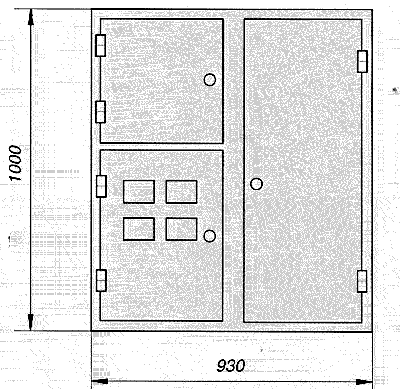
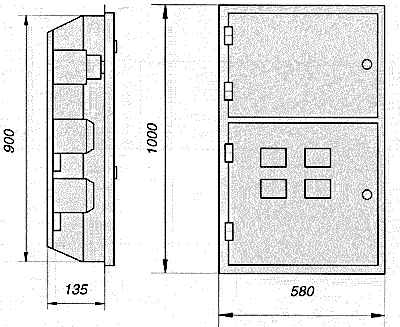
Table 5.2.1. Types of shields ShchE
* Note: at the request of the customer, shields can be made according to other typical schemes. It is also possible to complete the shields with protective shutdown devices.
The purpose of the floor board (SHE) is to power several apartments, and install television and telephone networks. It is also used in power and lighting installations of public, residential, industrial buildings, administrative and other buildings.

ShchE receive and distribute electricity in three, four and five-phase networks with a frequency of 50 Hz and a voltage of 220-380 V and with a grounded neutral. ShchE protects against overloads, short circuits and disconnections of group circuit lines.
Floor shield design
The design of the SC is presented in the form of a welded metal structure, which is divided by a special partition into three compartments. The first is the metering compartment, the second is the distribution compartment, and the third is the low-current compartment. In the first, a single-phase or three-phase meter is installed, in the second, circuit breakers and RCDs. The SE compartments are accessible through a door on the façade side. The door of the first compartment has a special window made of durable transparent material. Through it, meter readings are taken.
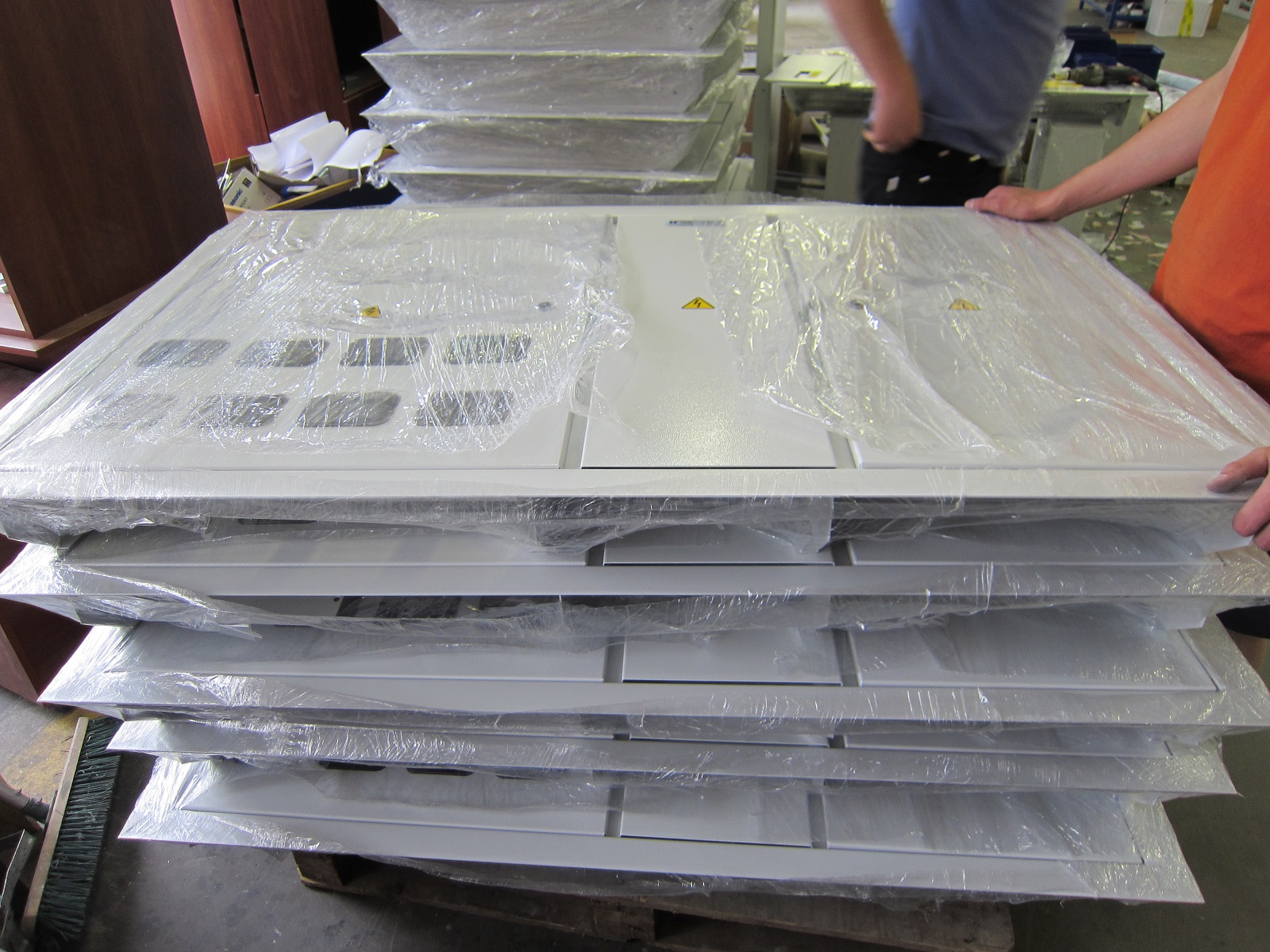

A storey shield is an electrical equipment that performs the functions of receiving, distributing and metering electricity in a certain area. The shield is conditionally divided into two components: a body made of steel, and hardware filling inside. In addition, inside the shield is divided into three compartments, each of which has its own functions and is equipped with special equipment:
- Residual shutdown block. It works during power surges and during a short circuit;
- Accounting block. Places in itself counters for the account of the electric power;
- Block of low-voltage equipment. It houses telephone and television hubs.
Servicing of the SE and anti-vandal measures
The body of the shield serves to protect against the actions of intruders and the general safety of users. The switchgear is locked, and in apartment buildings it has special windows for metering electricity and taking readings from meters. Maintenance of the SC is carried out with the help of the utility service.
The internal structure of the switchgear and operating modes
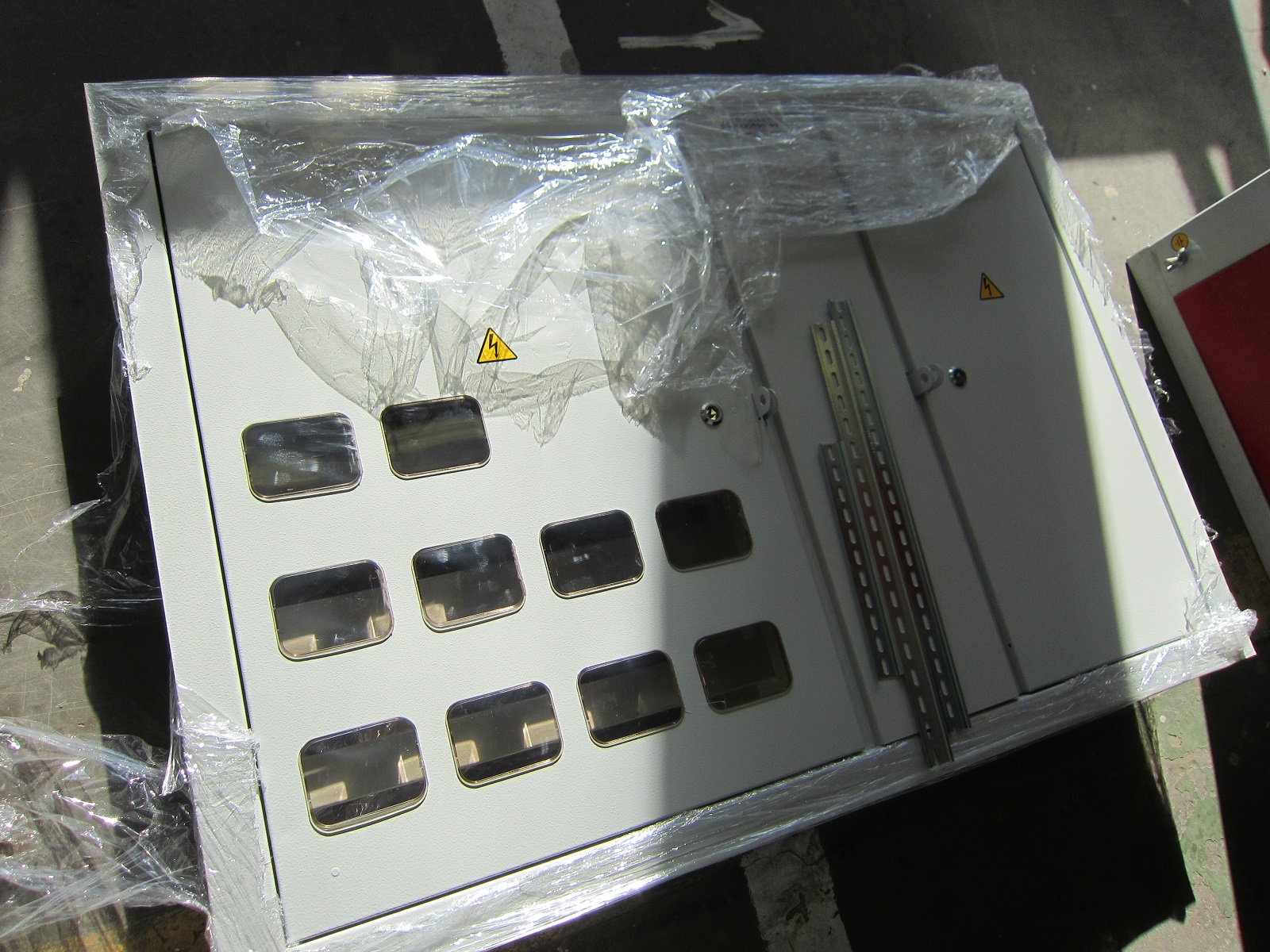
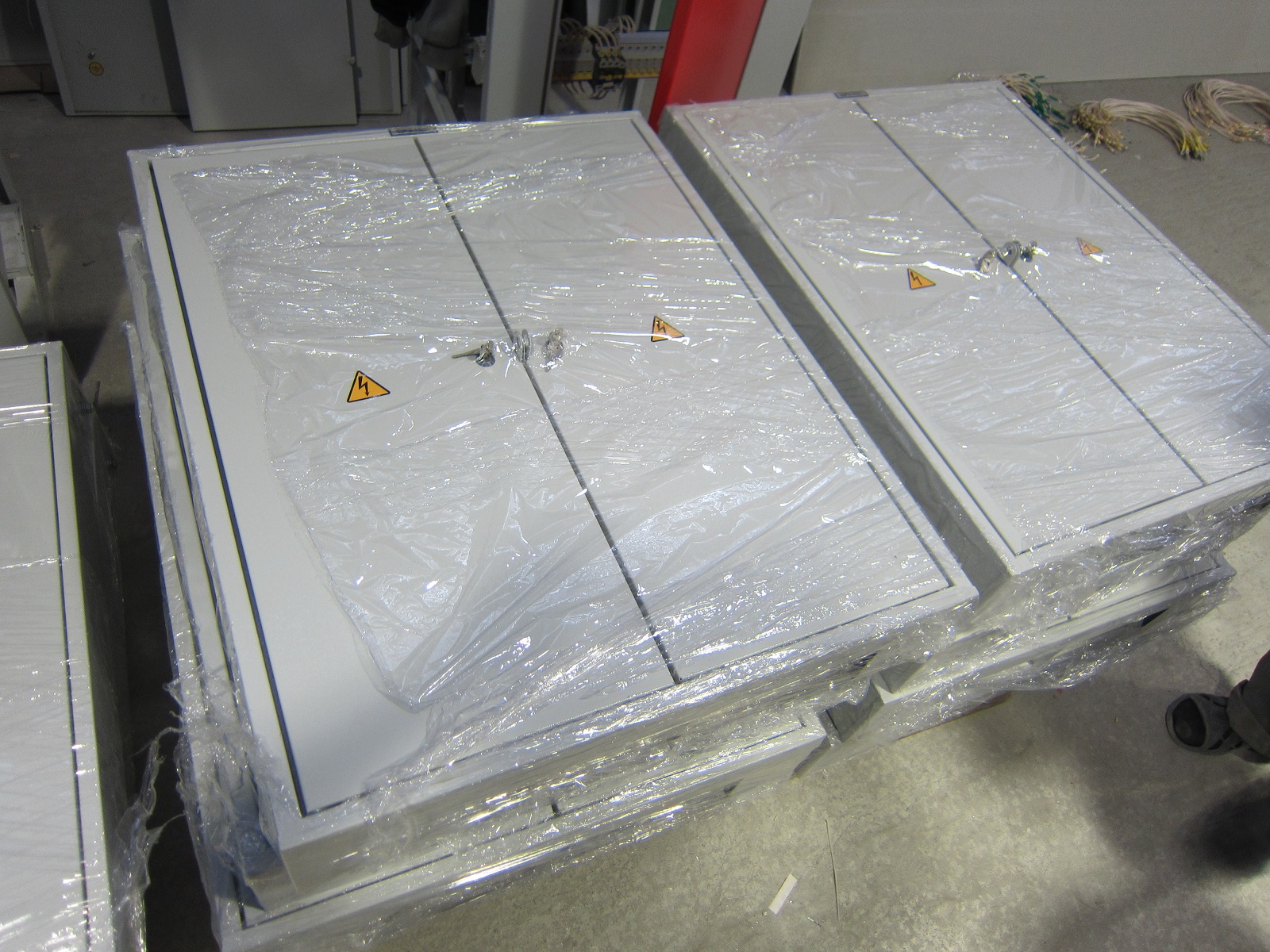
Most often, floor shields serve 2 or 3 lines. Each switchgear is equipped circuit breaker, residual current device and various equipment for line protection. Due to the reliable insulating material and materials that do not overheat with electric current, the likelihood of overheating, insulation damage, short circuit or fire is extremely small.
Switchgear Safety and Mounting Limitations
Compliance with electrical requirements, the standard nature of the shield and the type of its execution determine the reliability factor of this device. The safety during the operation of the switchgear depends on the cable material, its cross section and the type of connection. The selection of apparatus and cable material is carried out under the guidance of specialists.





